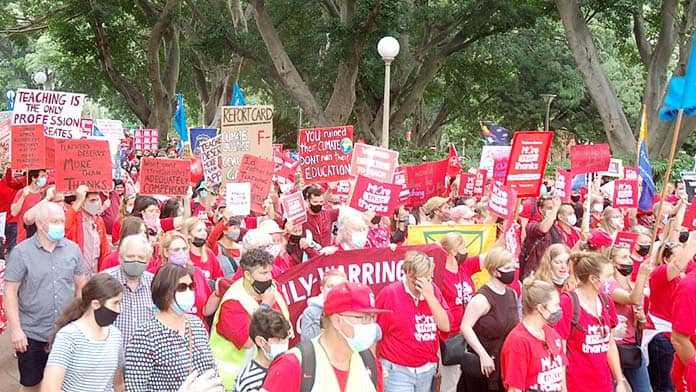Public school teachers in NSW walked off the job for our first strike in a decade on Tuesday, with almost 400 schools completely shut and many others cancelling classes and offering only basic supervision.
Up to 15,000 teachers flooded Hyde Park in Sydney as well as regional rallies across the state. Chants of “What do we want? More than thanks!” echoed through a sea of red T-shirts as we marched down Macquarie Street towards NSW parliament.
Importantly, the strike went ahead in defiance of an Industrial Relations Commission ruling against the action.
On the same day, there was public transport chaos as unions staged industrial action across Sydney’s train and bus system. Around 75 per cent of train services were cancelled, while bus drivers staged a 24-hour strike in Sydney’s southwest.
Pressure is mounting to break the NSW Liberal government’s public sector pay cap of 2.5 per cent a year pay rises, which translates to a pay cut with inflation running at 3 per cent in the past year.
Our NSW Teachers Federation demands are for an additional two hours per week for preparation time and a 5-7.5 per cent pay increase per year.
Vicious attack
In response NSW Education Minister Sarah Mitchell launched a vicious attack on teachers and their union, claiming it was a “protection racket” that was “ignoring the needs of students”. She doubled down later in the day, accusing teachers of causing more disruption in one day than COVID through the whole last term.
Teachers Federation President Angelo Gavrielatos told the strike rally this was “gratuitous attack on you, and a gratuitous attack on your union” that was “not acceptable”.
In fact, what is continually disrupting students’ learning is a lack of COVID safety measures in schools, a shortage of teachers, teachers teaching outside of their subject areas, and the never-ending administrative work that takes us away from lesson planning.
These issues need to be addressed, and it has come to industrial action to make that clear. The Department of Education and the NSW Liberal Government bear full responsibility for the disruption.
One teacher at an inner west school explained the scale of the teacher shortage, telling the rally there had been 250 times this year they had been unable to find enough teachers to run classes, explaining, “There was one day when we had four classes combined in the school library because there was no teacher to take those classes. Two weeks ago, in the one day, we had 11 classes left under minimal supervision.
“It is not just my school. One of our partner primary schools the next suburb down … spend up to four hours every night to try to find casual teachers for the next day.”
As Angelo Gavrielatos told the rally, “It’s high time that this government, rather than taking legal action, in an attempt to intimidate us and silence us, take action to fix the teacher shortage.”
The government’s own reports, he said, have found that, “Uncompetitive salaries and increased expectations, also known as crippling workloads, are making the profession less attractive.
“There has been no change in release time since the 1980s for primary school teachers and the 1950s for secondary school teachers. Enough’s enough.”
Catholic system
The Independent Education Union, which represent teachers in the private sector, announced its intention to strike over the same issues around workloads and pay when its agreement in the Catholic system expires early next year.
“Unless employers meet those claims there’s the possibility of protected industrial action in term one next year,” the union’s NSW deputy secretary Carol Matthews said.
United strike action by workers across sectors will only strengthen our struggles.
Unions NSW Secretary Mark Morey also addressed the rally adding, “Today is not the end, today is the start of industrial campaigning across this state to ensure everyone is paid appropriately, our people are looked after, and the services are provided.”
To break the 2.5 per cent pay cap and win the reduction in workload we need, further industrial action is likely to be needed. The turnout and militancy of teachers on strike shows we are ready for it.
By Vivian Honan
Join a forum with other rank-and-file teachers:
What’s the next step?
6.30pm Wednesday 15 December via Zoom, link to join at https://bit.ly/3ipnvgg
Share experiences so far and discuss how we can build the campaign. More info at https://fb.me/e/1pwnHd1o7






